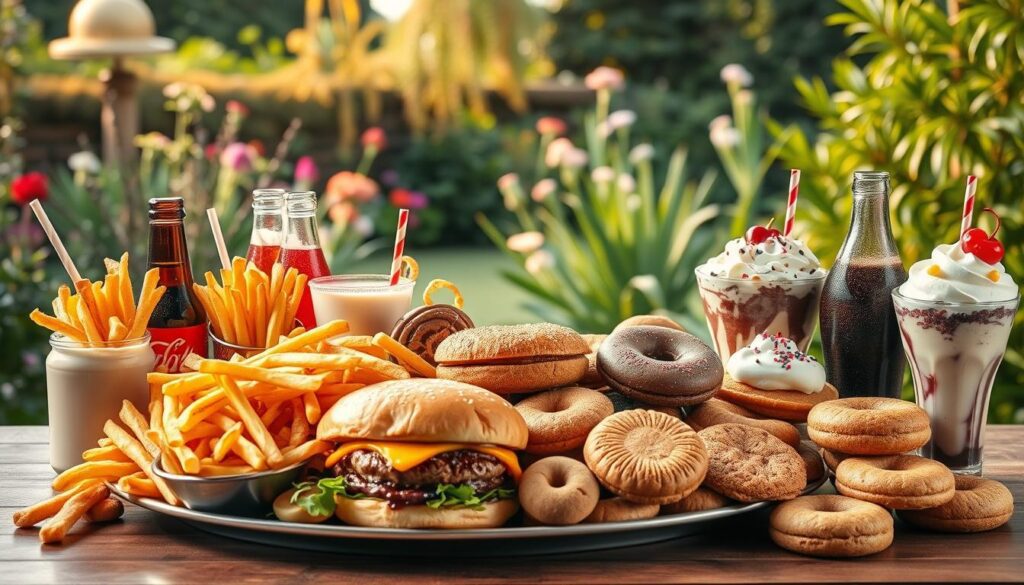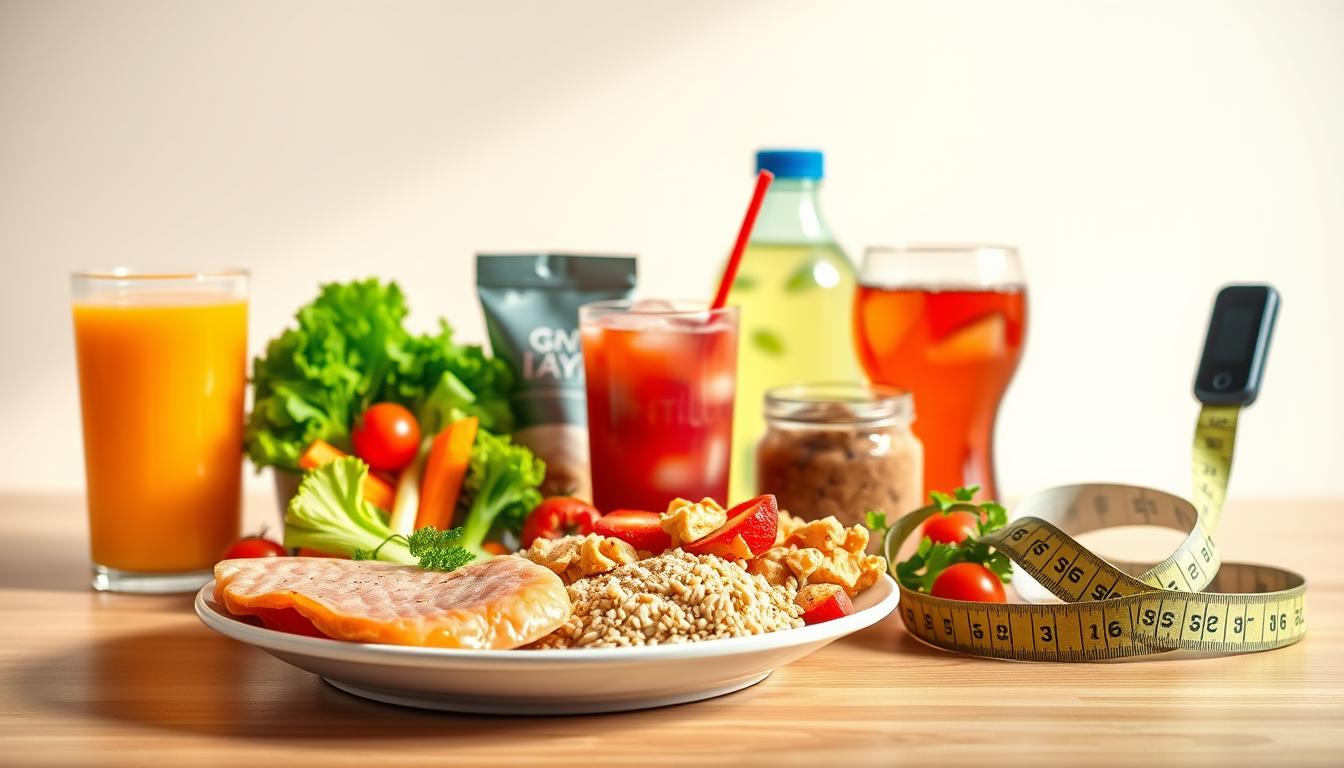You’re hitting the gym often, lifting heavier, and staying on track. But, your progress has hit a wall. What if the issue isn’t your workout but what you eat? Certain foods marketed as “healthy” might secretly undermine your physique goals, leaving you frustrated despite your hard work.
Many fitness folks overlook how everyday snacks and drinks can mess up their results. Flavored yogurts, for example, often have more sugar than candy bars. Sports drinks might replace lost electrolytes but also add empty calories. These choices add up, creating a gap between effort and visible muscle definition.
This isn’t about extreme diets or cutting out whole food groups. It’s about being aware. Small changes in what you eat can break through plateaus and help you get the lean, defined look you want. Ready to find out which foods are hiding in plain sight?
Key Takeaways
- Some “healthy” foods contain hidden sugars and additives that counteract muscle-building efforts.
- Fitness plateaus often stem from overlooked dietary choices, not just exercise habits.
- Reading nutrition labels carefully helps identify sneaky calorie-dense ingredients.
- Swapping processed snacks for whole-food alternatives supports better muscle definition.
- Hydration plays a dual role—sugary drinks can negate progress, while water aids recovery.
How Everyday Foods Hide Muscle-Defining Dangers
Your kitchen might have foods that look harmless but harm your fitness goals. Foods that seem healthy often have hidden ingredients that ruin muscle definition. Let’s find out why your healthy eating habits might not give you the toned body you want.
The Diet-Muscle Definition Connection
Getting lean means every bite matters—but not all “good” foods work. You need the right nutrition for muscle definition: enough protein and not too many calories. Even small mistakes in diet can slow your progress, often from foods that seem safe.
Why “Healthy” Doesn’t Always Mean Muscle-Friendly
Flavored Greek yogurt is a favorite for many health fans. It has 12g of protein per serving, but some have up to 20g of added sugar. As researcher Jim Stoppani says:
“Excess fructose from sweetened foods converts to fat faster than other carbs, directly opposing muscle visibility.”
This problem also happens with “low-fat” processed foods. Companies use sugars or artificial stuff to keep taste. Your body handles these differently, leading to insulin spikes and fat storage.
How Hidden Sugars and Fats Disrupt Progress
Fruit smoothies are another example. Blending many fruits makes their sugars more concentrated. A 16oz smoothie can have 50g of fructose, like eating 5 apples. This sugar turns into triglycerides, causing stubborn fat.
Sports drinks and protein bars also have hidden dangers. They promise to boost performance but often have 10-15g of added sugars. These sugars keep your body in fat-storage mode, hiding the muscle definition you’ve worked for.
5 ‘Innocent’ Foods Sabotaging Your Muscle Definition
You might think you’re making smart food choices, but some seemingly healthy options are secretly working against your gains. Let’s break down five common culprits that could be undermining your muscle definition – and what to swap them with for better results.

1. Flavored Greek Yogurt
Why it’s a problem: Sugar overload in disguise
That vanilla or strawberry yogurt cup packs up to 15g of added sugar – nearly 4 teaspoons. While protein content seems good, the insulin spike from excess sugar can trigger fat storage around muscles, blurring definition.
What to eat instead: Plain Greek yogurt + fresh berries
Choose unsweetened versions and add fresh blueberries or raspberries. You’ll get natural sweetness plus antioxidants that support recovery. Pro tip: Sprinkle chia seeds for extra fiber!
2. Granola Bars
Why it’s a problem: Calorie-dense energy traps
Many commercial bars contain 200-300 calories with sugary binders. A recent study found 78% of “protein bars” actually have more carbs than protein – terrible for maintaining lean mass during cuts.
What to eat instead: Homemade protein bars
Mix oats, whey protein, almond butter, and dark chocolate chips. You’ll control ingredients while getting 20g of clean protein per serving. Perfect for post-workout recovery without the junk.
3. Fruit Smoothies
Why it’s a problem: Liquid sugar avalanche
One Jamba Juice® medium smoothie delivers 24g sugar – equal to 6 Oreos! Liquid calories don’t trigger fullness signals, leading to overconsumption that hides abdominal muscles.
What to eat instead: Green veggie-based blends
Try spinach, avocado, unsweetened almond milk, and half a banana. Add collagen peptides for muscle support. As coach Charles R. advises: “Chew your calories – don’t drink them.”
4. Veggie Chips
Why it’s a problem: Fried masquerading as healthy
Most store-bought versions are just potato chips dyed green. A 1-oz serving has 150 calories and 9g fat – same as regular chips! The frying process destroys nutrients while adding empty calories.
What to eat instead: Roasted chickpeas
Toss canned chickpeas with olive oil, smoked paprika, and nutritional yeast. Bake until crispy for a high-fiber snack with 6g protein per serving. Crunch without the crash!
5. Sports Drinks
Why it’s a problem: Electrolyte imbalance risk
Gatorade® contains 34g sugar per 20oz bottle – more than a Snickers® bar! Excessive sodium can also cause water retention, making muscles look soft even at low body fat.
What to eat instead: Coconut water + pinch of salt
Natural coconut water provides potassium, while a salt pinch replaces lost sodium. Add lime juice for flavor – you’ll get clean hydration without the sugar crash.
| Food Trap | Hidden Issue | Better Swap |
|---|---|---|
| Flavored Yogurt | 15g added sugar | Plain Greek + berries |
| Granola Bars | Low protein ratio | Homemade protein bars |
| Fruit Smoothies | Liquid calories | Green veggie blends |
| Veggie Chips | High-fat processing | Roasted chickpeas |
| Sports Drinks | Sugar overload | Coconut water mix |
Why These Foods Trick Even Health-Conscious Eaters
You’re doing everything right—reading labels, choosing “natural” options, and avoiding obvious junk. So why does progress stall? The answer lies in clever marketing tactics and psychological triggers. These tricks make seemingly innocent foods quietly sabotage your muscle definition goals.
Marketing vs. Reality in Food Labeling
Words like “protein-packed” or “veggie-based” plastered on packaging often hide nutritional pitfalls. Veggie chips, for example, use potato starch as their base while charging premium prices for trace vegetable powders. A 2023 analysis found barbecue sauces labeled “low-fat” contained 40% more sugar than regular versions—a tradeoff that derails fat loss.
“Choosing hot sauce over sugary barbecue sauce saves you 200 empty calories per meal—that’s two extra pounds of fat monthly if you eat it daily,”
| Sauce Type | Calories/Tbsp | Sugar (g) | Fat (g) |
|---|---|---|---|
| Barbecue | 45 | 11 | 0.2 |
| Hot Sauce | 5 | 0 | 0 |
| Teriyaki | 35 | 8 | 0.1 |
The “Health Halo” Effect Explained
When foods get branded as healthy, your brain downplays their risks. That “organic” granola bar? You might unconsciously eat three instead of one, thinking they’re harmless. Research shows people consume 30% more calories from perceived “healthy” snacks due to this mental shortcut.
This effect ties directly to dopamine release: seeing words like “clean” or “superfood” triggers reward signals. This makes you feel virtuous while overeating. Combine this with Third Source’s BLTs (bites, licks, and tastes) concept, and those “harmless” samples at Whole Foods could add 500 stealthy weekly calories.
Conclusion
Your journey to better muscle definition starts with smarter food choices. Avoiding hidden traps like sugary sports drinks or veggie chips is key. But, true progress comes from combining clean eating with recovery strategies.
Studies show that proper hydration and 7-9 hours of sleep boost protein synthesis as well as some workouts. This is important for muscle growth.
Try these three swaps this week: Choose plain Chobani Greek yogurt over flavored versions (save 12g sugar per serving). Grab RXBAR protein bars instead of Quaker Chewy granola bars. Swap Jif Natural peanut butter for regular spreads.
These changes cut empty calories while keeping meals satisfying. They help you stay on track with your fitness goals.
Remember, muscle definition thrives on consistency. Track your progress through energy levels and workout performance, not just the mirror. Pair your improved nutrition with foam rolling and dynamic stretching to maximize results.
Small shifts in daily habits create lasting changes. Your next protein shake tastes better when you know it’s working smarter, not harder.







